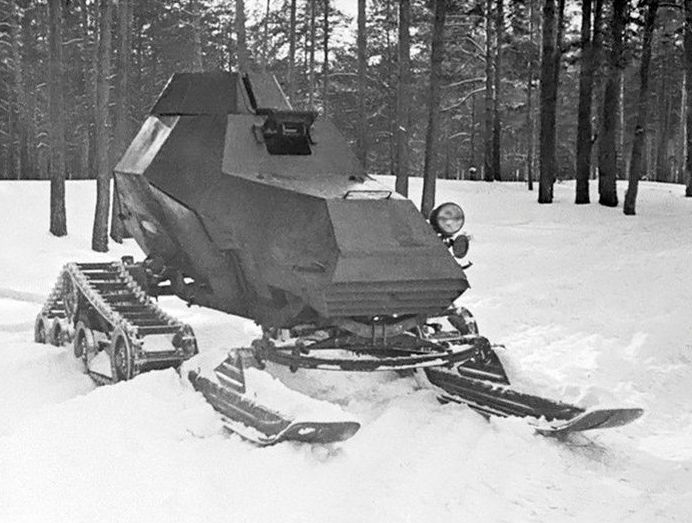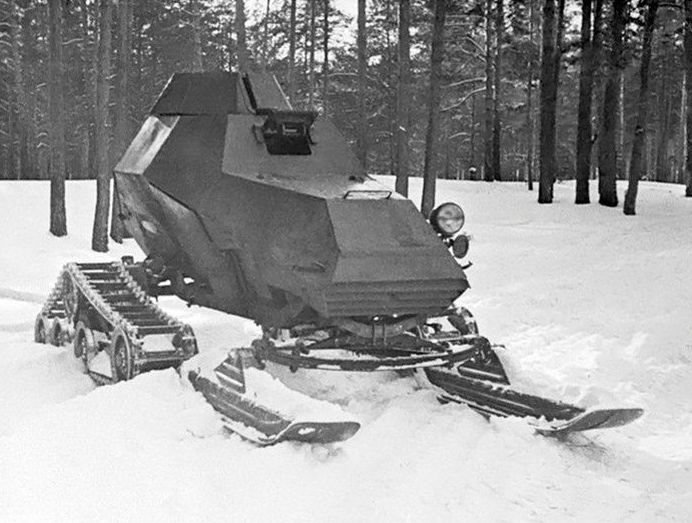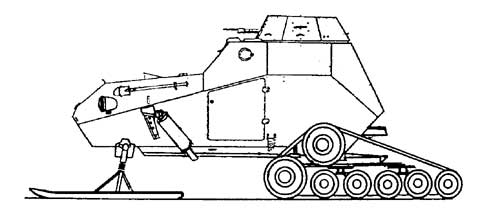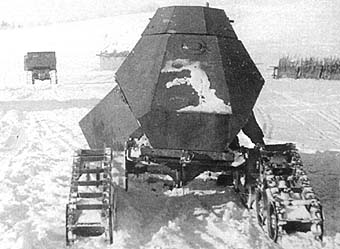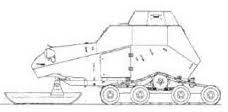BA-64Z
Trying to solve a problem of truck's movement over a snowy terrain in winter 1942 the new truck GAZ-SKh was developed (it was based on the chassis of the GAZ-AA). Instead of common wheels, the truck had the original track unit which has been developed before the Great Patriotic War (Chief-engineer - S.S.Nezhdanovsky). The driving-wheels were replaced with track unit, the front wheels were replaced with pair of a wide skis.
Then, the idea to install the BA-64 onto Nezhdanovsky's track unit suggested. From July 1943, the works on this idea started. The very first prototype was finished by January 1944. New vehicle received the BA-64Z designation ("Z" means "zimniy" - winter). The brakes, absorbers, the driving shaft, distribution box and the reserve wheel were removed from the new vehicle. The overall dimensions of the BA-64Z increased: length - 4560 mm, width - 2280 mm, height - 2020 mm. The full weight increased up to 2980 kilos.
On January 9, 1944, the first trials begun, but finished unsuccessfully: the BA-64Z stuck. It was dragged out by the GAZ-62 truck. From January 13, the trials resumed, now the BA-64Z towed the field gun. (Unfortunately, the report does not clarify the model, just mentioned "a field gun". The 76 mm ZIS-3 field gun seems to me most likely however).
BA-64Z run very well, but fell into the ditch and damaged the skis. From January 30 to February 10, 1944, the BA-64Z successfully passed the overall trials. The average speed on the hilly snowy terrain was 7.6 km/h, on the firm road - 16 km/h. The maximum theoretical speed - 28 km/h - was nor achieved because of weak engine. The car run with a big difficulties over the non-snowed flat terrain, and could not pass the hills at all if they weren't covered by snow. The tracks often collapsed. BA-64Z used too many fuel: 1.2-1.5 litres per kilometer.
The trials revealed another big problem of the BA-64Z: a quite low maneuverability. That was especially bad for wooded country, sometime it was need to saw off a tries to get a path. Because of these serious problems, the BA-64Z was considered as hopeless and all further works were cancelled.
Then, the idea to install the BA-64 onto Nezhdanovsky's track unit suggested. From July 1943, the works on this idea started. The very first prototype was finished by January 1944. New vehicle received the BA-64Z designation ("Z" means "zimniy" - winter). The brakes, absorbers, the driving shaft, distribution box and the reserve wheel were removed from the new vehicle. The overall dimensions of the BA-64Z increased: length - 4560 mm, width - 2280 mm, height - 2020 mm. The full weight increased up to 2980 kilos.
On January 9, 1944, the first trials begun, but finished unsuccessfully: the BA-64Z stuck. It was dragged out by the GAZ-62 truck. From January 13, the trials resumed, now the BA-64Z towed the field gun. (Unfortunately, the report does not clarify the model, just mentioned "a field gun". The 76 mm ZIS-3 field gun seems to me most likely however).
BA-64Z run very well, but fell into the ditch and damaged the skis. From January 30 to February 10, 1944, the BA-64Z successfully passed the overall trials. The average speed on the hilly snowy terrain was 7.6 km/h, on the firm road - 16 km/h. The maximum theoretical speed - 28 km/h - was nor achieved because of weak engine. The car run with a big difficulties over the non-snowed flat terrain, and could not pass the hills at all if they weren't covered by snow. The tracks often collapsed. BA-64Z used too many fuel: 1.2-1.5 litres per kilometer.
The trials revealed another big problem of the BA-64Z: a quite low maneuverability. That was especially bad for wooded country, sometime it was need to saw off a tries to get a path. Because of these serious problems, the BA-64Z was considered as hopeless and all further works were cancelled.

